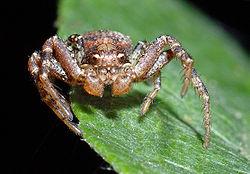Scientific classification:
Kingdom (Regnum): Animalia
Phylum (Phylum): Arthropoda
Class (Classis): Arachnida
Order (Ordo): Araneae
Family (Familia): Thomisidae
Thomisidae is one of the families of the Araneomorphae, containing about 3000 species.
Distribution: It can be found in whole Europe and in the Middle East, and also in some places over North-America and Asia.
Habitat: Typically it lives in the undergrowth, but sometimes it can be found under tree barks or on lower branches of trees.
Morphology, physical description: Unlike insects, their bodies consist of two tagmata, sets of segments that serve similar functions: the foremost one, called the cephalothorax or prosoma, is a complete fusion of the segments that in an insect would form two separate tagmata, the head and thorax; the rear tagma is called the abdomen or opisthosoma. Crab spiders have a wide, flattened, sometimes angular abdomen. Their body length is 1,5-3,5 mm, the male and the female can easily be distinguished. They are called crab spiders because they resemble crabs, with two front pairs of legs being longer than the others and angeled outward.
The body length of Ozyptila Praticola females is about 4 mm, the males are somewhat smaller, about 3 mm. Both sexes are of a dark reddish brown.
Diet: Spiders (order Araneae) are air-breathing arthropods that have eight legs, and chelicerae with fangs that inject venom. Crab spiders (who abush their prey) feast on bees and butterflies more often, than on other insects. Crab spiders don’t build webs to trap pray. They wait their pray to come standing still in one place on flowers or on the ground. If it is close enough, the spider grabs it with its legs and paralizes the pray with a venomous bite. Like most of the spiders, crab spiders also inject strong digestive enzymes into their paralized preys. This strong salvia then liquifies the tissues and then the spider sucks out these fluids, only leaving an empty husk.
Behaviour: Crab spiders can move, and also run backwards or sideways (like Carcinus maenas). They do not build webs, only egg sacs. They pray during daytime. Species living on flowers are able to adopt to the color of the flower; the brown ones usually live on leaves or on the ground. Ther lifespan is about one year.
Reproduction: They mate during summer. The female guards the eggs, which are sticked to plants in egg sacks. It takes 2-3 weeks to the eggs to hatch.
Role in the ecosystem: It prays on many types of inescts, including pest sas well.
Conservation status: Ozyptila Praticola is rated ’least concern’, they aren’t protected in Hungary.
http://en.wikipedia.org/wiki/Ozyptila_praticola
http://en.wikipedia.org/wiki/Crab_spider
http://hu.wikipedia.org/wiki/Thomisidae
